Application of Machine Learning to Diagnostics of Schizophrenia Patients Based on Event-Related Potentials
Abstract
1. Introduction
2. Materials and Methods
2.1. Subjects
2.2. EEG Recording and Processing
2.3. Experimental Setup
2.4. Event-Related Potentials
- ‘Plus1’: Condition with an image of an animal as the first stimulus in the trial and arbitrary second stimulus. For channels T5, O1, O2, and T6, the interval from 320 ms to 520 ms after the first stimulus was taken. This interval and localization corresponded to the P3Cue wave of the ERPs (Figure 1) [29,30].
- ‘Plus2’: Condition with an image of an animal as the first stimulus in the trial and arbitrary second stimulus. For channels P3, Pz, and P4, the interval was from 900 ms to 1080 ms. The selected interval corresponded to the contingent negative variation (CNV) wave of the ERPs observed just before the expected stimulus presentation (Figure 1) [31].
- ‘NoGo’: Condition with an image of an animal as the first stimulus and an image of a plant as the second one. Selected channels were C3, Cz, C4, P3, Pz, and P4 with an interval from 300 ms to 500 ms after the second stimuli (Figure 2).
- ‘Go’: Condition with an image of an animal as both stimuli. Channels of interest were C3, Cz, C4, P3, Pz, and P4 with an interval from 250 ms to 450 ms after the second stimuli. Selected intervals for NoGo and Go conditions corresponded to the P300 wave for NoGo stimuli (P300 NOGO) and P300 wave for Go stimuli (P3b) observed within 300–500 ms over the frontal and parietal cortex correspondingly (Figure 2 and Figure 3) [32,33,34].
- ‘P-H’: Condition with an image of a plant as the first stimulus and an image of a human as the second stimulus. Selected channels were C3, Cz, and C4 with an interval from 160 ms to 220 ms after the second stimuli. The interval and localization corresponded to P3a wave elicited by infrequent unpredictable stimuli [32].
2.5. Behavioral Data
2.6. Algorithm Description
2.6.1. Feature Engineering
- The random normally distributed feature was added to the training dataset. After fitting, the model shap-values [35] were calculated for each feature. All features that had a shap-value less than the random feature were eliminated;
- Sequential feature selection where the model was trained on the full set of features and after that, the features were eliminated one by one in greedy fashion so that the performance of the model does not decrease;
- Combination of the above approaches: features with non-random shap-values were selected with successive sequential feature selection;
- Truncated SVD, which performs the linear dimensionality reduction. The number of features to leave was calculated based on their cumulative explained variance.
2.6.2. Considered Models
2.6.3. Pipeline Training
3. Results
3.1. Behavioral Parameters
3.2. Model Performance Metrics
3.3. Interpretation
4. Discussion
5. Conclusions
6. Limitations and Future Directions
- Some of the patients were under medication at the time of the EEG recording. Unfortunately, the interruption of medication in patients with severe symptoms could not be implemented due to ethical issues.
- Another limitation was that the sources of the brain signals were located far from the scalp surface and the respective EEG sensors. Together with volume conductance, it led to overlapping of the brain signals in the EEG recordings. Therefore, we were not able to identify the specific localization of the observed effects based only on the topographies of the EEG potentials. In future studies, we intend to apply the method of extracting latent components of the ERPs [54] to isolate signals from individual brain sources. As shown in the previous papers of the authors [20], the analysis of latent components has the advantage of revealing differences in the parameters of brain responses between groups in intergroup comparisons.
Author Contributions
Funding
Institutional Review Board Statement
Informed Consent Statement
Data Availability Statement
Conflicts of Interest
References
- Owen, M.; Sawa, A.; Mortensen, P. Schizophrenia. Lancet 2016, 388, 86–97. [Google Scholar] [CrossRef] [PubMed]
- McEvoy, J.P. The importance of early treatment of schizophrenia. Behav. Health 2007, 27, 40–43. [Google Scholar]
- Bowie, C.R.; Harvey, P.D. Cognitive deficits and functional outcome in schizophrenia. Neuropsychiatr. Dis. Treat. 2006, 2, 531–536. [Google Scholar] [CrossRef] [PubMed]
- Orellana, G.; Slachevsky, A.; Peña, M. Executive attention impairment in first-episode schizophrenia. BMC Psychiatry 2012, 12, 154. [Google Scholar] [CrossRef]
- Rinaldi, R.; Lefebvre, L. Goal-directed behaviors in patients with schizophrenia: Concept relevance and updated model. Psychiatry Clin. Neurosci. 2016, 70, 394–404. [Google Scholar] [CrossRef]
- Mayer, A.R.; Hanlon, F.M.; Dodd, A.B.; Yeo, R.A.; Haaland, K.Y.; Ling, J.M.; Ryman, S.G. Proactive response inhibition abnormalities in the sensorimotor cortex of patients with schizophrenia. J. Psychiatry Neurosci. 2016, 41, 312–321. [Google Scholar] [CrossRef]
- Perez, V.B.; Ford, J.M.; Roach, B.J.; Woods, S.W.; McGlashan, T.H.; Srihari, V.H.; Loewy, R.L.; Vinogradov, S.; Mathalon, D.H. Error monitoring dysfunction across the illness course of schizophrenia. J. Abnorm. Psychol. 2012, 121, 372–387. [Google Scholar] [CrossRef]
- Cadena, E.J.; White, D.M.; Kraguljac, N.V.; Reid, M.A.; Lahti, A.C. Evaluation of fronto-striatal networks during cognitive control in unmedicated patients with schizophrenia and the effect of antipsychotic medication. Schizophrenia 2018, 4, 8. [Google Scholar] [CrossRef]
- Battaglia, S.; Cardellicchio, P.; Di Fazio, C.; Nazzi, C.; Fracasso, A.; Borgomaneri, S. Stopping in (e)motion: Reactive action inhibition when facing valence-independent emotional stimuli. Front. Behav. Neurosci. 2022, 16, 252. [Google Scholar] [CrossRef]
- Warren, S.L.; Crocker, L.D.; Spielberg, J.M.; Engels, A.S.; Banich, M.T.; Sutton, B.P.; Miller, G.A.; Heller, W. Cortical organization of inhibition-related functions and modulation by psychopathology. Front. Hum. Neurosci. 2013, 7, 271. [Google Scholar] [CrossRef]
- Schröder, J.; Wenz, F.; Schad, L.R.; Baudendistel, K.; Knopp, M.V. Sensorimotor Cortex and Supplementary Motor Area Changes in Schizophrenia: A Study with Functional Magnetic Resonance Imaging. Br. J. Psychiatry 1995, 167, 197–201. [Google Scholar] [CrossRef]
- Akar, S.A.; Kara, S.; Latifoğlu, F.; Bilgiç, V. Analysis of the Complexity Measures in the EEG of Schizophrenia Patients. Int. J. Neural Syst. 2016, 26, 1650008. [Google Scholar] [CrossRef]
- Kutepov, I.E.; Krysko, V.A.; Krysko, A.V.; Pavlov, S.P.; Zigalov, M.V.; Papkova, I.V.; Saltykova, O.A.; Yaroshenko, T.Y.; Krylova, E.Y.; Yakovleva, T.V.; et al. Complexity of EEG Signals in Schizophrenia Syndromes. In Proceedings of the 29th International Conference on Computer Graphics and Vision, Bryansk, Russia, 23–26 September 2019. [Google Scholar]
- Zhang, L. EEG Signals Classification Using Machine Learning for The Identification and Diagnosis of Schizophrenia. In Proceedings of the 41st Annual International Conference of the IEEE Engineering in Medicine and Biology Society (EMBC), Berlin, Germany, 23–27 July 2019; Volume 2019, pp. 4521–4524. [Google Scholar] [CrossRef]
- Kropotov, J.D.; Mueller, A. What can event related potentials contribute to neuropsychology. Acta Neuropsychol. 2009, 7, 169–181. [Google Scholar]
- Kropotov, J.D.; Pronina, M.V.; Ponomarev, V.A.; Murashev, P.V. In Search of New Protocols of Neurofeedback: Independent Components of Event-Related Potentials. J. Neurother. 2011, 15, 151–159. [Google Scholar] [CrossRef]
- DeLaRosa, B.L.; Spence, J.S.; Motes, M.A.; To, W.; Vanneste, S.; Kraut, M.A.; Hart, J. Identification of selection and inhibition components in a Go/NoGo task from EEG spectra using a machine learning classifier. Brain Behav. 2020, 10, e01902. [Google Scholar] [CrossRef]
- Ertekin, E.; Üçok, A.; Keskin-Ergen, Y.; Devrim-Üçok, M. Deficits in Go and NoGo P3 potentials in patients with schizophrenia. Psychiatry Res. 2017, 254, 126–132. [Google Scholar] [CrossRef]
- Sun, Q.; Fang, Y.; Shi, Y.; Wang, L.; Peng, X.; Tan, L. Inhibitory Top-Down Control Deficits in Schizophrenia With Auditory Verbal Hallucinations: A Go/NoGo Task. Front. Psychiatry 2021, 12, 884. [Google Scholar] [CrossRef]
- Kropotov, J.D.; Pronina, M.V.; Ponomarev, V.A.; Poliakov, Y.I.; Plotnikova, I.V.; Mueller, A. Latent ERP components of cognitive dysfunctions in ADHD and schizophrenia. Clin. Neurophysiol. 2019, 130, 445–453. [Google Scholar] [CrossRef]
- Oribe, N.; Hirano, Y.; Kanba, S.; Del Re, E.; Seidman, L.; Mesholam-Gately, R.; Goldstein, J.M.; Shenton, M.; Spencer, K.M.; McCarley, R.W.; et al. Progressive reduction of visual P300 amplitude in patients with first-episode schizophrenia: An ERP study. Schizophr. Bull. 2015, 41, 460–470. [Google Scholar] [CrossRef]
- Mueller, A.; Candrian, G.; Kropotov, J.D.; Ponomarev, V.A.; Baschera, G.-M. Classification of ADHD patients on the basis of independent ERP components using a machine learning system. Nonlinear Biomed. Phys. 2010, 4, S1. [Google Scholar] [CrossRef]
- Müller, A.; Vetsch, S.; Pershin, I.; Candrian, G.; Baschera, G.-M.; Kropotov, J.D.; Kasper, J.; Rehim, H.A.; Eich, D. EEG/ERP-based biomarker/neuroalgorithms in adults with ADHD: Development, reliability, and application in clinical practice. World J. Biol. Psychiatry 2019, 21, 172–182. [Google Scholar] [CrossRef] [PubMed]
- Franke, G.H. BSI. Brief Symptom Inventory—Deutsche Version. Manual; Beltz: Göttingen, Germany, 2000. [Google Scholar]
- Barkley, R.A.; Murphy, K.R. Attention-Deficit Hyperactivity Disorder: A Clinical Workbook, 3rd ed.; The Guilford Press: New York, NY, USA, 2006. [Google Scholar]
- Kay, S.R.; Fiszbein, A.; Opler, L.A. The Positive and Negative Syndrome Scale (PANSS) for Schizophrenia. Schizophr. Bull. 1987, 13, 261–276. [Google Scholar] [CrossRef] [PubMed]
- Jung, T.-P.; Makeig, S.; Westerfield, M.; Townsend, J.; Courchesne, E.; Sejnowski, T.J. Removal of eye activity artifacts from visual event-related potentials in normal and clinical subjects. Clin. Neurophysiol. 2000, 111, 1745–1758. [Google Scholar] [CrossRef] [PubMed]
- Ponomarev, V.A.; Mueller, A.; Candrian, G.; Grin-Yatsenko, V.A.; Kropotov, J.D. Group Independent Component Analysis (gICA) and Current Source Density (CSD) in the study of EEG in ADHD adults. Clin. Neurophysiol. 2014, 125, 83–97. [Google Scholar] [CrossRef]
- Karayanidis, F.; Jamadar, S.; Ruge, H.; Phillips, N.; Heathcote, A.; Forstmann, B.U. Advance preparation in task-switching: Converging evidence from behavioral, brain activation, and model-based approaches. Front. Psychol. 2010, 1, 25. [Google Scholar] [CrossRef]
- De Baene, W.; Albers, A.M.; Brass, M. The what and how components of cognitive control. Neuroimage 2012, 63, 203–211. [Google Scholar] [CrossRef]
- Aydin, M.; Carpenelli, A.L.; Lucia, S.; Di Russo, F. The Dominance of Anticipatory Prefrontal Activity in Uncued Sensory–Motor Tasks. Sensors 2022, 22, 6559. [Google Scholar] [CrossRef]
- Polich, J. Updating P300: An integrative theory of P3a and P3b. Clin. Neurophysiol. 2007, 118, 2128–2148. [Google Scholar] [CrossRef]
- Huang, W.-J.; Chen, W.-W.; Zhang, X. The neurophysiology of P 300—An integrated review. Eur. Rev. Med. Pharmacol. Sci. 2015, 19, 1480–1488. [Google Scholar]
- Bokura, H.; Yamaguchi, S.; Kobayashi, S. Electrophysiological correlates for response inhibition in a Go/NoGo task. Clin. Neurophysiol. 2001, 112, 2224–2232. [Google Scholar] [CrossRef]
- Štrumbelj, E.; Kononenko, I. Explaining prediction models and individual predictions with feature contributions. Knowl. Inf. Syst. 2013, 41, 647–665. [Google Scholar] [CrossRef]
- Borra, S.; Di Ciaccio, A. Measuring the prediction error. A comparison of cross-validation, bootstrap and covariance penalty methods. Comput. Stat. Data Anal. 2010, 54, 2976–2989. [Google Scholar] [CrossRef]
- Pedregosa, F.; Varoquaux, G.; Gramfort, A.; Michel, V.; Thirion, B.; Grisel, O.; Blondel, M.; Prettenhofer, P.; Weiss, R.; Dubourg, V. Scikit-learn: Machine Learning in Python. JMLR 2011, 12, 2825–2830. [Google Scholar]
- Ford, J.M.; Mathalon, D.H. Electrophysiological evidence of corollary discharge dysfunction in schizophrenia during talking and thinking. J. Psychiatr. Res. 2003, 38, 37–46. [Google Scholar] [CrossRef]
- Pallanti, S.; Salerno, L. Raising attention to attention deficit hyperactivity disorder in schizophrenia. World J. Psychiatry 2015, 5, 47–55. [Google Scholar] [CrossRef]
- Kaiser, S.; Roth, A.; Rentrop, M.; Friederich, H.C.; Bender, S.; Weisbrod, M. Intra-individual reaction time variability in schizophrenia, depression and borderline personality disorder. Brain Cogn. 2008, 66, 73–82. [Google Scholar] [CrossRef]
- Weissman, D.H.; Roberts, K.C.; Visscher, K.M.; Woldorff, M. The neural bases of momentary lapses in attention. Nat. Neurosci. 2006, 9, 971–978. [Google Scholar] [CrossRef]
- Lundberg, S.; Lee, S.-I. A Unified Approach to Interpreting Model Predictions. In Proceedings of the 31st International Conference on Neural Information Processing Systems—NIPS’17, Long Beach, CA, USA, 4–9 December 2017; pp. 4768–4777. [Google Scholar]
- Barros, C.; Silva, C.A.; Pinheiro, A.P. Advanced EEG-based learning approaches to predict schizophrenia: Promises and pitfalls. Artif. Intell. Med. 2021, 114, 102039. [Google Scholar] [CrossRef]
- Santos, F.E.; Ontivero, O.M.; Valdés, S.M.; Sahli, H. Machine Learning Techniques for the Diagnosis of Schizophrenia Based on Event-Related Potentials. Front. Neuroinform. 2022, 16, 893788. [Google Scholar] [CrossRef]
- Hoonakker, M.; Doignon-Camus, N.; Marques-Carneiro, J.E.; Bonnefond, A. Sustained attention ability in schizophrenia: Investigation of conflict monitoring mechanisms. Clin. Neurophysiol. 2017, 128, 1599–1607. [Google Scholar] [CrossRef]
- Barceló, F.; Periáñez, J.A.; Nyhus, E. An information theoretical approach to task-switching: Evidence from cognitive brain potentials in humans. Front. Hum. Neurosci. 2008, 2, 13. [Google Scholar] [CrossRef] [PubMed]
- Gajewski, P.D.; Falkenstein, M. Diversity of the P3 in the task-switching paradigm. Brain Res. 2011, 1411, 87–97. [Google Scholar] [CrossRef] [PubMed]
- Lin, Y.X.; Zhang, L.J.; Ying, L.; Zhou, Q. Cognitive effort-avoidance in patients with schizophrenia can reflect Amotivation: An event-related potential study. BMC Psychiatry 2020, 20, 344. [Google Scholar] [CrossRef] [PubMed]
- Catalano, L.T.; Wynn, J.K.; Lee, J.; Green, M.F. A comparison of stages of attention for social and nonsocial stimuli in schizophrenia: An ERP study. Schizophr. Res. 2021, 238, 128–136. [Google Scholar] [CrossRef]
- Giordano, G.M.; Perrottelli, A.; Mucci, A.; Di Lorenzo, G.; Altamura, M.; Bellomo, A.; Brugnoli, R.; Corrivetti, G.; Girardi, P.; Monteleone, P.; et al. Investigating the Relationships of P3b with Negative Symptoms and Neurocognition in Subjects with Chronic Schizophrenia. Brain Sci. 2021, 11, 1632. [Google Scholar] [CrossRef]
- Escera, C.; Alho, K.; Winkler, I.; Näätänen, R. Neural Mechanisms of Involuntary Attention to Acoustic Novelty and Change. J. Cogn. Neurosci. 1998, 10, 590–604. [Google Scholar] [CrossRef]
- Fisher, D.J.; Campbell, D.J.; Abriel, S.C.; Ells, E.M.L.; Rudolph, E.D.; Tibbo, P.G. Auditory Mismatch Negativity and P300a Elicited by the “Optimal” Multi-feature Paradigm in Early Schizophrenia. Clin. EEG Neurosci. 2018, 49, 238–247. [Google Scholar] [CrossRef]
- Giordano, G.M.; Giuliani, L.; Perrottelli, A.; Bucci, P.; Di Lorenzo, G.; Siracusano, A.; Brando, F.; Pezzella, P.; Fabrazzo, M.; Altamura, M.; et al. Mismatch Negativity and P3a Impairment through Different Phases of Schizophrenia and Their Association with Real-Life Functioning. J. Clin. Med. 2021, 13, 5838. [Google Scholar] [CrossRef]
- Metsomaa, J.; Sarvas, J.; Ilmoniemi, R.J. Blind Source Separation of Event-Related EEG/MEG. IEEE Trans. Biomed. Eng. 2016, 64, 2054–2064. [Google Scholar] [CrossRef]
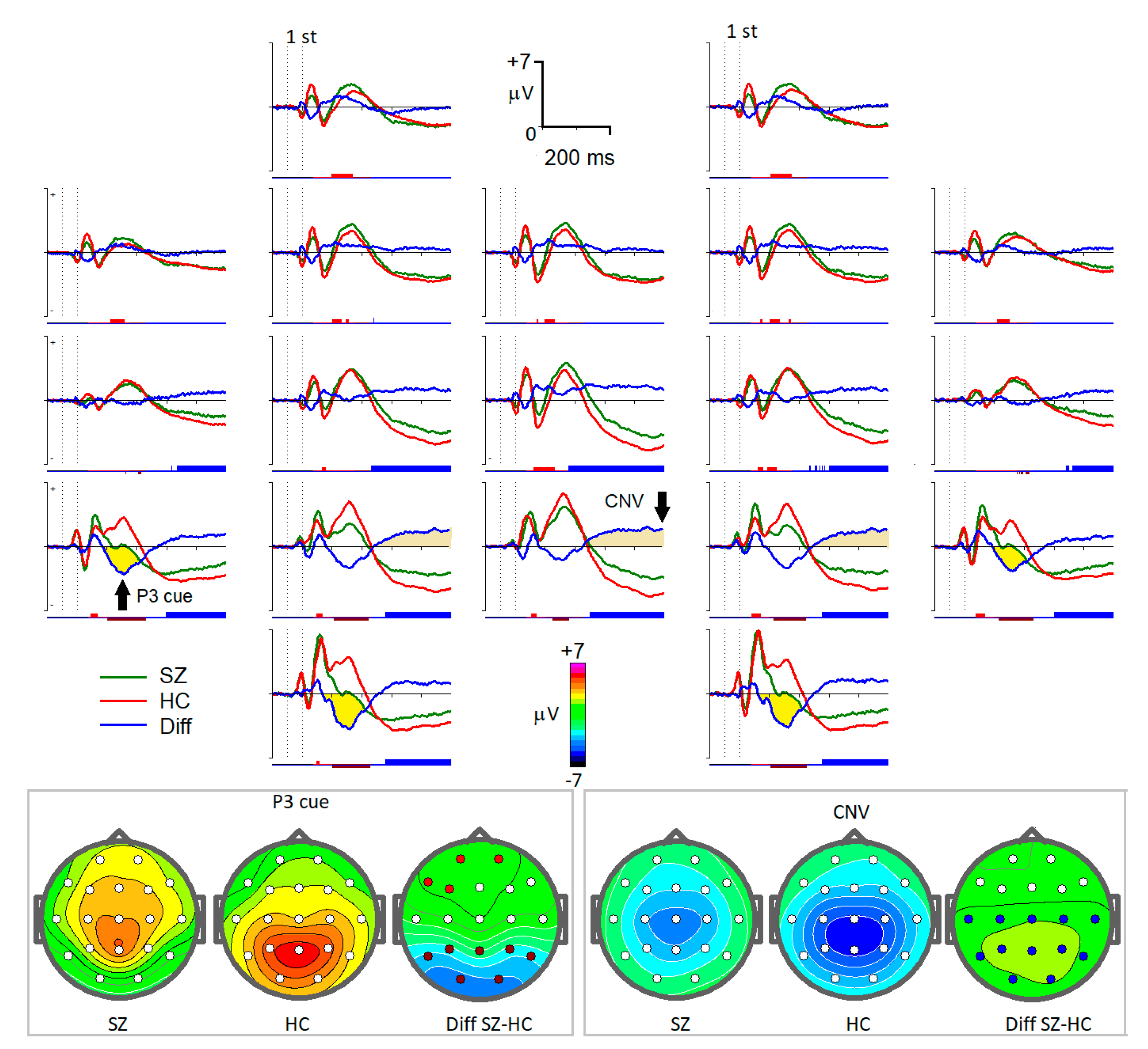
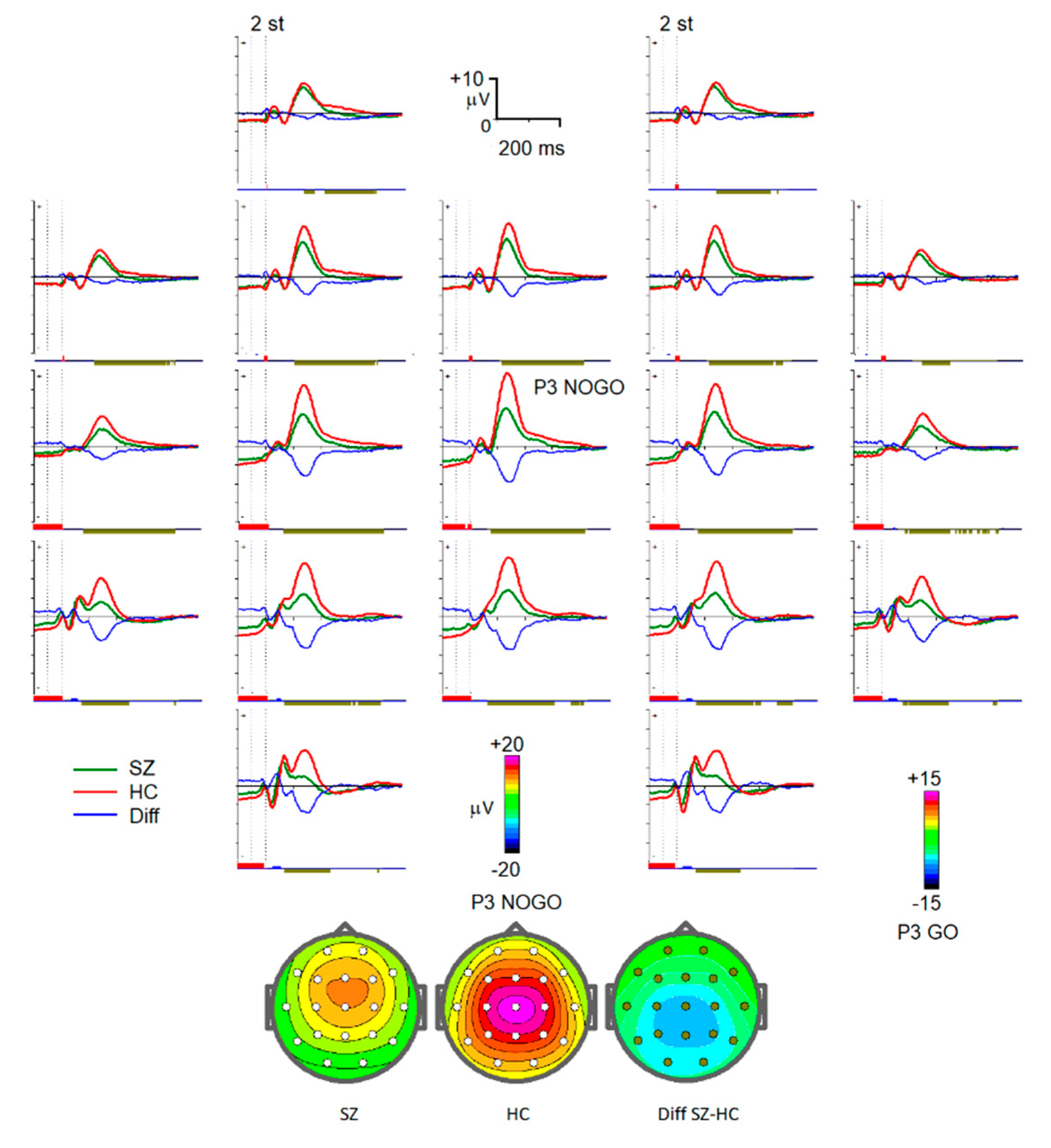
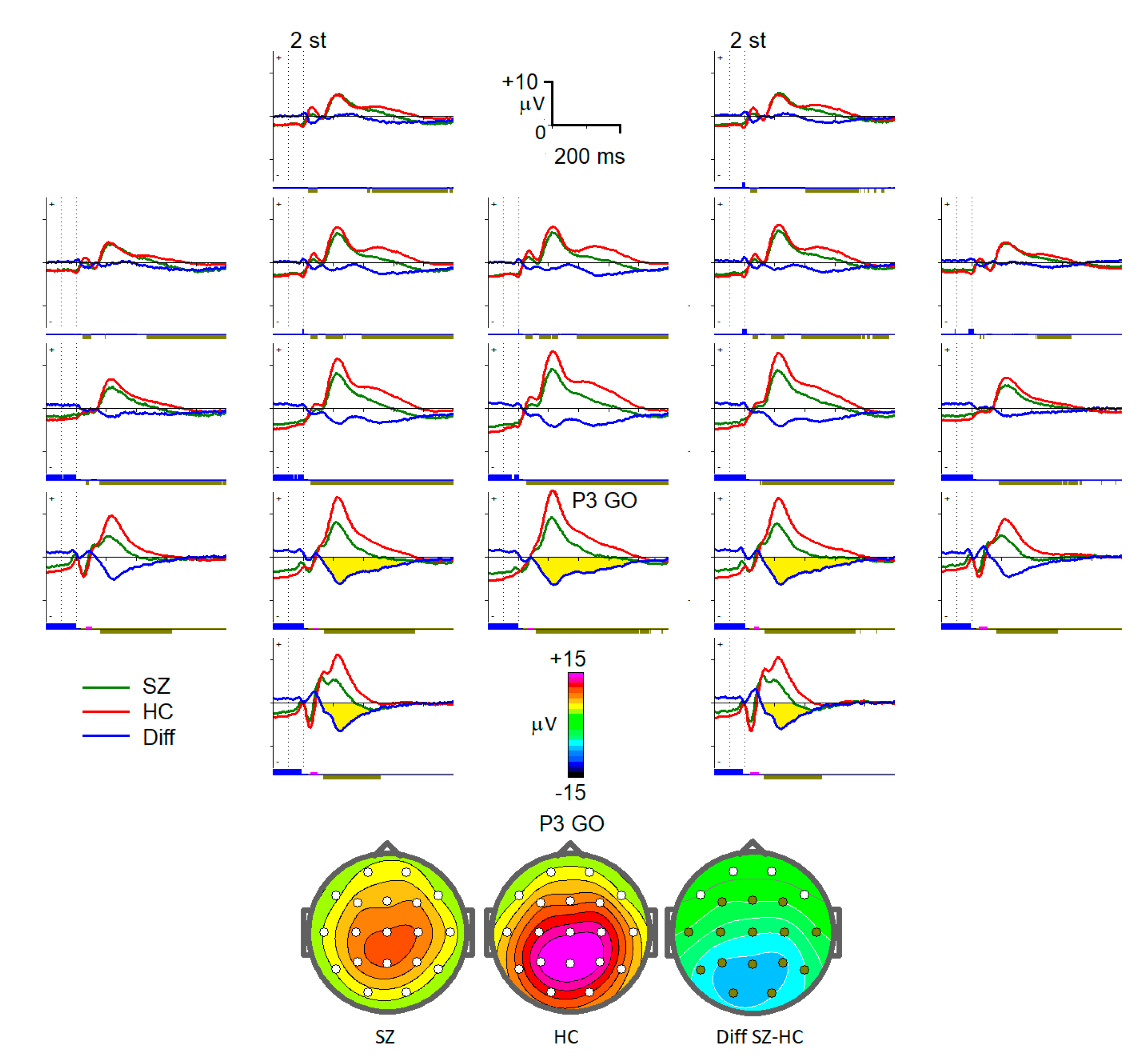
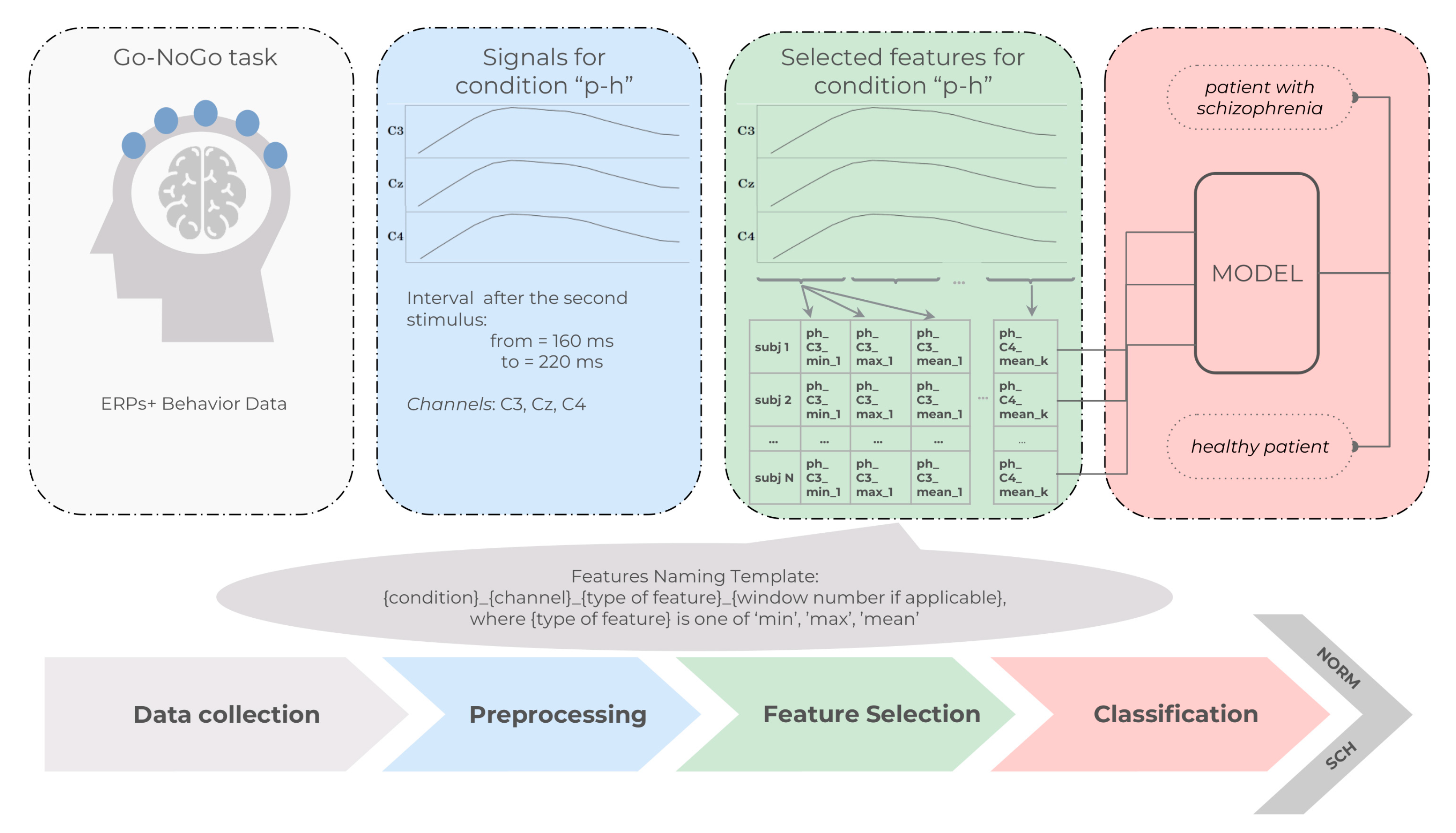
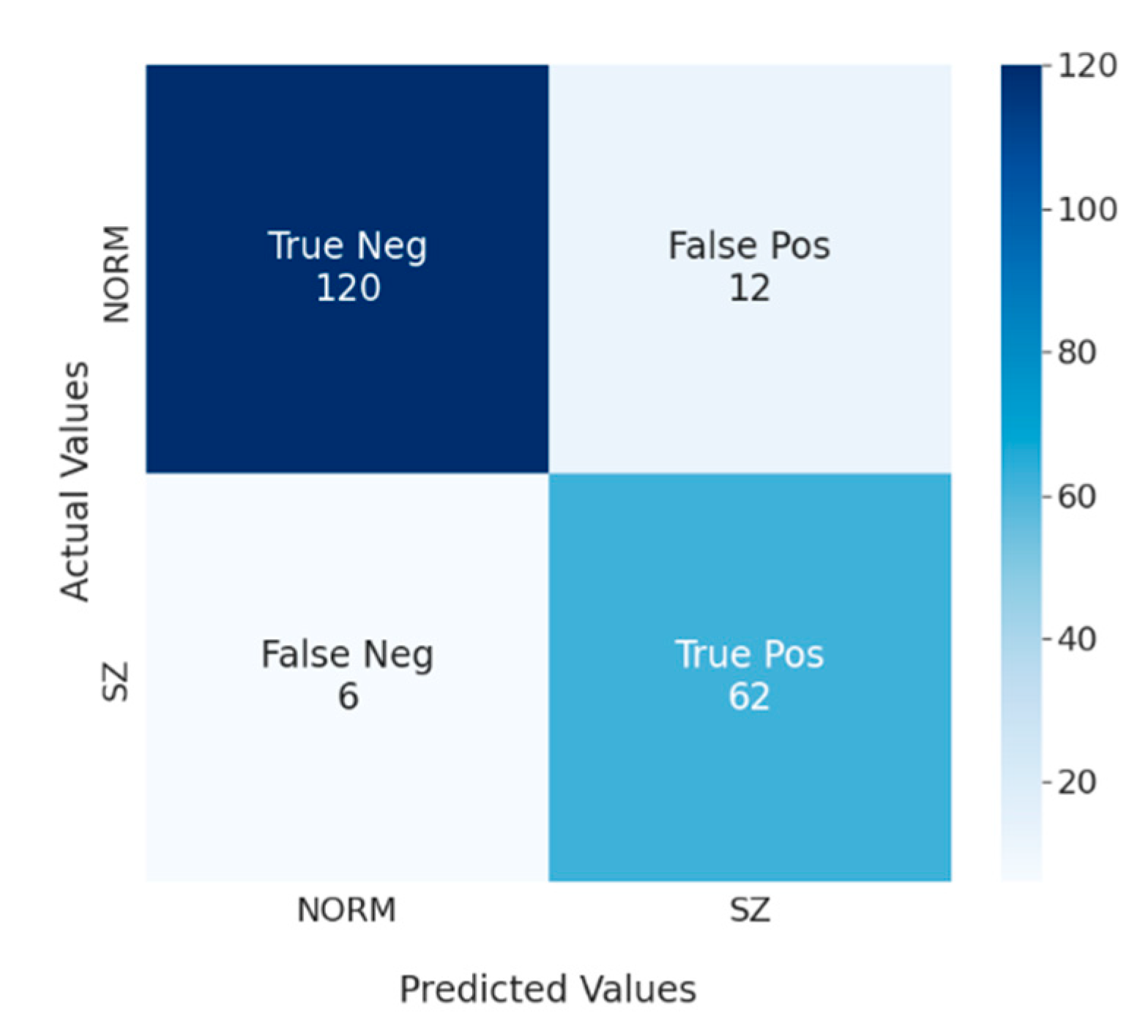


| Subject Group | Mean Age | Misses in % Mean ± SE | False Clicks in % Mean ± SE | Reaction Time in % Mean ± SE | Reaction Time Variance Mean ± SE |
|---|---|---|---|---|---|
| Healthy | 31.8 | 1.6 ± 2.8 | 0.7 ± 1.3 | 379 ± 79 | 8.4 ± 2.6 |
| Schizophrenia | 30.6 | 9.4 ± 11.4 | 2.0 ± 6.7 | 416 ± 92 | 12.0 ± 4.8 |
| Difference F [1, 198], p< | 1, 0.32 | 56.7, 0.001 | ns | 8.9, 0.01 | 48.5, 0.001 |
| Model | Sensitivity | Specificity | F1 | AUC |
|---|---|---|---|---|
| LR | 0.848 ± 0.166 | 0.855 ± 0.159 | 0.806 ± 0.159 | 0.851 ± 0.125 |
| LR (behavior) | 0.862 ± 0.132 | 0.863 ± 0.149 | 0.820 ± 0.127 | 0.862 ± 0.097 |
| LR (behavior, SFS) | 0.890 ± 0.128 | 0.885 ± 0.099 | 0.846 ± 0.079 | 0.888 ± 0.060 |
| kNN | 0.833 ± 0.186 | 0.856 ± 0.093 | 0.783 ± 0.134 | 0.845 ± 0.101 |
| kNN (behavior) | 0.867 ± 0.175 | 0.871 ± 0.098 | 0.815 ± 0.137 | 0.869 ± 0.102 |
| kNN (behavior, SFS) | 0.895 ± 0.130 | 0.916 ± 0.054 | 0.867 ± 0.098 | 0.906 ± 0.075 |
| Stacking (behavior) | 0.862 ± 0.116 | 0.871 ± 0.118 | 0.822 ± 0.124 | 0.866 ± 0.093 |
| SVM | 0.893 ± 0.121 | 0.886 ± 0.103 | 0.849 ± 0.125 | 0.890 ± 0.090 |
| SVM (SFS) | 0.912 ± 0.096 | 0.908 ± 0.083 | 0.877 ± 0.098 | 0.910 ± 0.074 |
| SVM (shap, SFS) | 0.895 ± 0.094 | 0.901 ± 0.103 | 0.863 ± 0.079 | 0.898 ± 0.055 |
| SVM (SFSB) | 0.907 ± 0.124 | 0.910 ± 0.091 | 0.872 ± 0.108 | 0.909 ± 0.080 |
| SVM (behavior) | 0.907 ± 0.107 | 0.902 ± 0.082 | 0.866 ± 0.091 | 0.904 ± 0.067 |
| SVM (behavior, SFS) | 0.895 ± 0.114 | 0.896 ± 0.097 | 0.854 ± 0.107 | 0.895 ± 0.080 |
| SVM (behavior, shap, SFS) | 0.876 ± 0.138 | 0.878 ± 0.116 | 0.833 ± 0.095 | 0.877 ± 0.072 |
| SVM (behavior, SFSB) | 0.910 ± 0.074 | 0.908 ± 0.083 | 0.877 ± 0.091 | 0.909 ± 0.067 |
| Condition | Window Size in ms | Window Shift in % |
|---|---|---|
| plus 1 | 49 | 50 |
| plus 2 | 5 | 50 |
| NO-GO | 49 | 100 |
| GO | 20 | 100 |
| P-H | 5 | 100 |
Disclaimer/Publisher’s Note: The statements, opinions and data contained in all publications are solely those of the individual author(s) and contributor(s) and not of MDPI and/or the editor(s). MDPI and/or the editor(s) disclaim responsibility for any injury to people or property resulting from any ideas, methods, instructions or products referred to in the content. |
© 2023 by the authors. Licensee MDPI, Basel, Switzerland. This article is an open access article distributed under the terms and conditions of the Creative Commons Attribution (CC BY) license (https://creativecommons.org/licenses/by/4.0/).
Share and Cite
Shanarova, N.; Pronina, M.; Lipkovich, M.; Ponomarev, V.; Müller, A.; Kropotov, J. Application of Machine Learning to Diagnostics of Schizophrenia Patients Based on Event-Related Potentials. Diagnostics 2023, 13, 509. https://doi.org/10.3390/diagnostics13030509
Shanarova N, Pronina M, Lipkovich M, Ponomarev V, Müller A, Kropotov J. Application of Machine Learning to Diagnostics of Schizophrenia Patients Based on Event-Related Potentials. Diagnostics. 2023; 13(3):509. https://doi.org/10.3390/diagnostics13030509
Chicago/Turabian StyleShanarova, Nadezhda, Marina Pronina, Mikhail Lipkovich, Valery Ponomarev, Andreas Müller, and Juri Kropotov. 2023. "Application of Machine Learning to Diagnostics of Schizophrenia Patients Based on Event-Related Potentials" Diagnostics 13, no. 3: 509. https://doi.org/10.3390/diagnostics13030509
APA StyleShanarova, N., Pronina, M., Lipkovich, M., Ponomarev, V., Müller, A., & Kropotov, J. (2023). Application of Machine Learning to Diagnostics of Schizophrenia Patients Based on Event-Related Potentials. Diagnostics, 13(3), 509. https://doi.org/10.3390/diagnostics13030509







